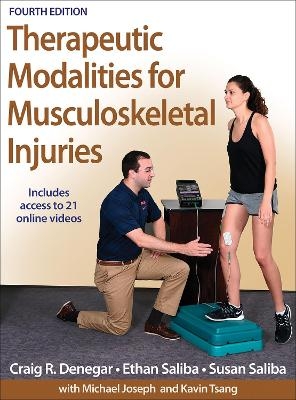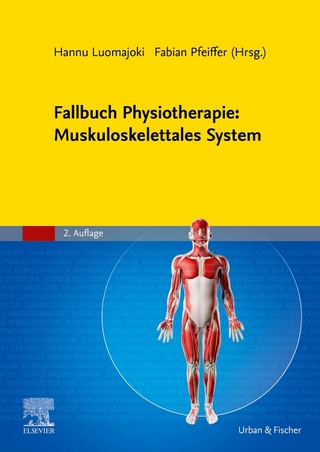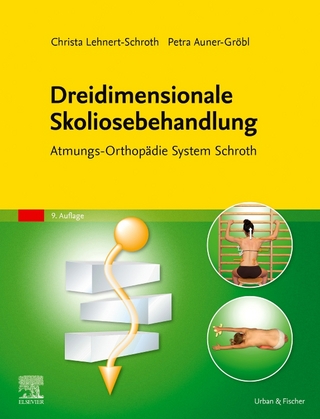
Therapeutic Modalities for Musculoskeletal Injuries
Human Kinetics (Verlag)
978-1-4504-6901-2 (ISBN)
Therapeutic Modalities for Musculoskeletal Injuries, Fourth Edition With Online Video, offers comprehensive coverage of evidence-based therapies for rehabilitation of musculoskeletal injuries. The information aligns with the Board of Certification’s Role Delineation Study/Practice Analysis, Sixth Edition, and the Commission on Accreditation of Athletic Training Education’s Athletic Training Education Competencies, Fifth Edition, and is a vital resource for students preparing for examinations as well as professionals in the field who wish to stay informed of the latest research.
Therapeutic Modalities for Musculoskeletal Injuries, Fourth Edition, applies evidence-based research and clinical experiences of top practitioners in the field to optimize the care of musculoskeletal injuries and provides students and practitioners with solid fundamentals in development of rehabilitation programs. The content of this fourth edition has been significantly updated and revitalized to include all modalities that coincide with BOC requirements and offers the latest in contemporary science in the field. Further updates include the following:
• New online video that corresponds to modalities discussed throughout the text, directly demonstrating how to apply techniques to individual patients
• A new chapter on mechanobiology that provides new understanding of the effects of movement and activity on cell function
• A new chapter on the application of exercise as a stimulus for tissue repair
• Additional information on the principles and clinical applications of cold, heat, electrotherapy, laser, and ultrasound
• Updated and revamped case studies and guided scenarios that apply all modalities found throughout the book to real-world situations
The content of the book is organized in parts to logically address therapeutic interventions for musculoskeletal injuries. Part I explains the core concepts of therapy, specifically in terms of clinical practice, and part II addresses the physiology of the acute response to tissue damage, tissue repair, and pain. Part III examines electrical modalities for pain management, provides an introduction to neuromuscular control, and addresses the use of biofeedback and neuromuscular stimulation to restore neuromuscular control in rehabilitation. Parts IV and V delve into a critical evaluation of therapeutic applications of cold, superficial heat, ultrasound, electromagnetic fields, and low-power laser therapy. Part VI examines foundational concepts of mechanobiology and explains how and why exercise and mechanical forces are essential to musculoskeletal tissue repair. Part VII brings all of the concepts from the text together through a series of case studies and guided scenarios, which allow students to apply fundamentals to real-world situations.
Therapeutic Modalities for Musculoskeletal Injuries, Fourth Edition With Online Video, contains many learning features to assist comprehension, including chapter objectives, key terms and a glossary, sidebars with clinical application of current concepts, and chapter summaries. Additionally, access to 21 online videos of applying modalities in clinical practice will help students better understand concepts from the text. For instructors, a robust set of ancillaries is provided, including a fully updated tesst package and instructor guide, as well as a newly added presentation package plus image bank to assist with lecture preparation.
Therapeutic Modalities for Musculoskeletal Injuries, Fourth Edition, explains how to apply each therapy and addresses why and when a therapeutic intervention can improve the outcome of care. Students and professionals alike will develop stronger decision-making skills when determining the safest and most effective use of each treatment method.
Craig R. Denegar, PhD, PT, ATC, FNATA, is a professor in the department of kinesiology and director of the doctor of physical therapy program at the University of Connecticut. He has more than 30 years of experience as an athletic trainer and physical therapist and has extensive clinical practice experience related to persistent orthopedic pain. Denegar is a member of the National Athletic Trainers’ Association (NATA) and the American Physical Therapy Association. He is editor in chief of the Journal of Athletic Training and serves on the editorial boards of the Journal of Sport Rehabilitation, Journal of Strength and Conditioning Research, and Open Access Journal of Sport Medicine. He is the former vice chair of free communications on the NATA Research and Education Foundation’s Research Committee and was the 2003 recipient of the William G. Clancy Medal for Distinguished Athletic Training Research and the 2004 Distinguished Merit Award from the Pennsylvania Athletic Trainers’ Society. Denegar was elected a fellow of the NATA in 2011 and recognized as a Most Distinguished Athletic Trainer by the NATA in 2014. Ethan Saliba, PhD, ATC, PT, has been teaching therapeutic modalities at the University of Virginia at Charlottesville for over 25 years. He is the head athletic trainer and associate athletics director for sports medicine, and he oversees 25 varsity sports. Saliba is a certified athletic trainer, licensed physical therapist, and sport-certified specialist who has written extensively on various aspects of athletic injuries and rehabilitation. Saliba was honored as the NATA Head Athletic Trainer of the Year in 2007. Susan Foreman Saliba, PhD, ATC, PT, is an associate professor in the Curry School of Education at the University of Virginia at Charlottesville. She has over 20 years of clinical experience and taught therapeutic modalities during that time. Susan is a member of both the NATA and the American Physical Therapy Association (APTA) and has served on the NATA Educational Executive Committee and the Free Communications Committee of the NATA Research and Education Foundation. She is conducting research on the clinical application of therapeutic modalities. About the Contributors Michael Joseph, PhD, PT, is an assistant professor in the department of kinesiology physical therapy program at the University of Connecticut. Joseph has more than 15 years of clinical experience as a physical therapist specializing in sports medicine and is a consultant for many professional and collegiate teams. He is a member of the American Physical Therapy Association and is on the editorial board of the Journal of Strength and Conditioning Research and the World Journal of Orthopedics. Joseph teaches clinical and musculoskeletal pathology, mechanobiology, and musculoskeletal evaluation and treatment. His focus of research is the adaptation of connective tissue to physiological loading. Kavin Tsang, PhD, ATC, is an associate professor in the department of kinesiology at California State University at Fullerton. He is an active member of the National Athletic Trainers’ Association (NATA) and an athletic trainer certified by the Board of Certification. His clinical experiences encompass physical therapy clinics, high school athletics, collegiate intramural programs, and intercolleegiate athletics. He has been teaching therapeutic modalities in various athletic training education curricula for over 14 years. Tsang serves on the NATA Research and Education Foundation (NATA REF) Board of Directors, NATA REF Free Communications Committee, NATA Convention Program Committee, and FWATA Education Program Committee. He is also chair of the Far West Athletic Trainers’ Association (FWATA) Research and Grants Committee.
Part I: Principles of Therapeutic Modalities and Rehabilitation
Chapter 1. Fundamentals of Therapeutic Modalities
Chapter 2. Psychological Aspects of Injury and Rehabilitation
Chapter 3. Evidence-Based Application of Therapeutic Modalities
Part II: Physiology of Pain and Injury
Chapter 4. Tissue Healing
Chapter 5. Pain and Pain Relief
Chapter 6. Clinical Management of Pain
Part III: Electrical Modalities and Nerve Stimulation
Chapter 7. Principles of Electrical Modalities
Chapter 8. Clinical Application of Electrical Stimulation for Pain
Chapter 9. Arthrogenic Muscle Inhibition and Clinical Applications of Electrical Stimulation and Biofeedback
Part IV: Cold and Superficial Heat Therapies
Chapter 10. Principles of Cold and Superficial Heat
Chapter 11. Clinical Applications of Cold and Superficial Heat
Part V: Ultrasound, Electromagnetic Fields, and Laser Therapies
Chapter 12. Principles of Ultrasound and Diathermy
Chapter 13. Clinical Application of Ultrasound and Diathermy
Chapter 14. Principles of Low-Level Laser Therapy
Chapter 15. Clinical Application of Low-Level Laser Therapy
Part VI: Mechanobiology, Exercise, and Manual Therapies
Chapter 16. Mechanobiology
Chapter 17. Applications of Exercise and Manual Therapy to Promote Repair
Chapter 18. Mechanical Energy and Manual Therapies
Part VII: Putting it All Together
Chapter 19. Case Scenarios
| Verlagsort | Champaign, IL |
|---|---|
| Sprache | englisch |
| Maße | 216 x 279 mm |
| Gewicht | 1406 g |
| Themenwelt | Sachbuch/Ratgeber ► Sport |
| Medizin / Pharmazie ► Medizinische Fachgebiete ► Orthopädie | |
| Medizin / Pharmazie ► Medizinische Fachgebiete ► Sportmedizin | |
| Medizin / Pharmazie ► Physiotherapie / Ergotherapie ► Rehabilitation | |
| ISBN-10 | 1-4504-6901-9 / 1450469019 |
| ISBN-13 | 978-1-4504-6901-2 / 9781450469012 |
| Zustand | Neuware |
| Haben Sie eine Frage zum Produkt? |
aus dem Bereich


